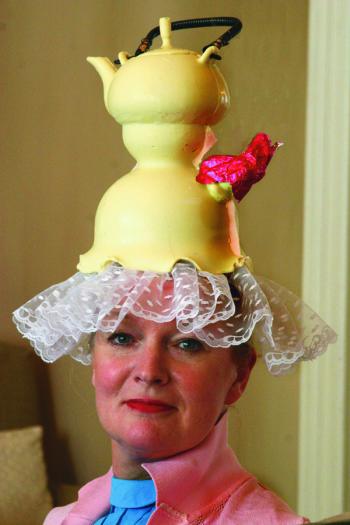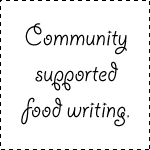Autistic chocolate
June 29, 2006

Chocolate hat © Ann de Gersem, photo C. Baele
A pink chocolate teapot hat? Pistachio green chocolate teacups with fur and pink foil? Dark chocolate whiskey snifter crystal ashtray bling? Ann de Gersem, a Design Academy Eindhoven MFA student graduates today with a collection of chocolate objects she designed in collaboration with the autistic employees of a Belgian chocolate factory. De Gersem, who isn’t autistic, wondered if the way autistics think could serve as a departure from conventional design methodology. Could autistic thinking lead to a new form of authenticity in design?

Chocolate hat © Ann de Gersem, photo C. Baele
De Gersem’s project, primarily the bit about designing within a culture that is not accepted as normative culture, the culture of autism, has broad implications. De Gersem’s Au(then)tism collection offers a visual language created in collaboration outside the culture of the neurologically typical. Writer, curator and activist, Ine Gevers wrote about this in 1999 in her essay, (En)countering the Culture of the Norm, for a one day seminar of the self-same title initiated by artist collective de Geuzen. Autists, according to Gevers, can be defined as those who are differently brained and whose language and/or (social) behavior deviates from the norm. By working with autistic people, de Gersem touches on the heart of what it means to design for ‘normative culture’ and therefore strikes at the heart of what is generally practiced as design.
Speaking of ‘normal’, normally designers graduate from design schools and get to work designing landfill as quick as you can say, ‘industrial designers should be more proactive in altering their practice of designing the Himalayas of waste’. But this is what I love about de Gersem’s approach. It’s not so much that her chocolate objects are ephemeral (discouraging the production, acquisition and accumulation of thingie-thingies), but that the method of their concepting and manufacture is designed to occur within the context of heterogeneity. In striving for authenticity, de Gersem embraces pure difference as a design technique. Design for differentnesss.

Frieda pours warm milk from a chocolate teapot © Ann de Gersem, photo C. Baele
Ine Gevers continues,

Dark and milk chocolate whiskey snifter ashtray bling © Ann de Gersem, photo C. Baele
So can we think of autsism as a culture? That’s a fiddly question! Read the front page of any newspaper anwhere at any time to smell the fetid disagreement about what a culture is or what should be its defining characteristics. The smartypants-hive-brain that is Wikipedia thinks thusly:
- … most cultural anthropologists as of 2006 define a culture as follows: (1) Culture is based on symbols, abstract ways of referring to and understanding ideas, objects, feelings, or behaviors -— and the ability to communicate with symbols using language. (2) Culture is shared. People in the same society share common behaviors and ways of thinking through culture. (3) Culture is learned. While people biologically inherit many physical traits and behavioral instincts, culture is socially inherited. A person must learn culture from other people in a society. (4) Culture is adaptive. People use culture to flexibly and quickly adjust to changes in the world around them. (Source: Encarta article on culture.)
According to these definitions, autistics are perhaps in the beginning stages of forming a real culture. Many features of what are commonly called cultures are visible in the autistic culture. There are shared beliefs, organisations, language, and art that are specific to the group, and there is a tendency to marry within the group. Autistic culture can be learned…
Amy Nelson (Aspies for Freedom) wrote a proposal on November 16, 2004 that the Autistic community are a social minority group and therefore should be considered as such by the United Nations.

Nelly and Wies in the salon © Ann de Gersem, photo C. Baele
If you still think de Gersem’s work is about autistic people, why don’t you substitute the word ‘autistic’ in this entry for Kurdish or Palestinian or Kirghizian or Afro-American or Afro-Carribic or Islamic or Syrian Christian or Sikh or Chicano or even Anorexic and you will immediately understand that designing with and for subcultures is a really hot issue. The autistics must be nodding Mona Lisa smiles at the notion of being the poster-child of this positively radical (design) notion. What page of the Talmud was it that says, ‘Culture is difference’?
- Writer, curator and acitivist Ine Gevers writes about the culture of autism (1999) in an essay titled, (En)countering the Culture of the Norm.
- Ann de Gersem’s Life Dress in We-Make-Money-Not-Art
- Design Academy’s Fun Lab, initially an institute for studying the future of ‘fun’, is a postgraduate course in experience design.
- Jim sinclair: Autism is not an impenetrable wall
You try to relate to your autistic child, and the child doesn’t respond. He doesn’t see you; you can’t reach her; there’s no getting through. That’s the hardest thing to deal with, isn’t it? The only thing is, it isn’t true.
Look at it again: You try to relate as parent to child, using your own understanding of normal children, your own feelings about parenthood, your own experiences and intuitions about relationships. And the child doesn’t respond in any way you can recognize as being part of that system.That does not mean the child is incapable of relating at all. It only means you’re assuming a shared system, a shared understanding of signals and meanings, that the child in fact does not share. It’s as if you tried to have an intimate conversation with someone who has no comprehension of your language. Of course the person won’t understand what you’re talking about, won’t respond in the way you expect, and may well find the whole interaction confusing and unpleasant.
- From Wikipedia: The autism rights movement (which has also been called autistic self-advocacy movement [1] and autistic liberation movement [2]) was started by adult autistic individuals in order to advocate and demand tolerance for what they refer to as neurodiversity. The movement is supported by some neurotypicals including parents of autistic children. The movement is controversial and has been criticized by some parents of autistic children who disagree with its anti-cure and pro-neurodiversity views.
- Neurodiversity Weblog
- Online test at Neurodiversity dot com. (An Interactive Exercise in the Recognition of Emotions from Facial Expressions). Sadly, I didn’t do very well for a neurotypical person.
Your score to date
correct: 16 wrong: 13 hit rate: 55%
- And proving that autistics DO have a sense of humor, the Institute for the Neurologically Typical

Chocolate hat © Ann de Gersem, photo C. Baele
Twenty-one international masters students will graduate this month from the Design Academy Eindhoven. The Masters Graduation Show will officially open on Thursday, June 29 at 16h00 in ‘de Witte Dame’ Emmasingel 14, Eindhoven. For more information call Anna Crosetti at +31(0)40 2393939 or anna.crosetti@designacademy.nl
Photo credits: Photos, Cleo Baele, models Frieda (pink teapot), Nelly, (green and white teapots), and Wies (dark chocolate bling).
debra at 1:20 | | post to del.icio.us


















Autistic chocolate
Ann de Gersem has just graduated from Design Academy Eindhoven with a collection of chocolate objects she designed in collaboration with the autistic employees of a Belgian chocolate factory. De Gersem was inspired by the way autistic people think and…
Trackback by we make money not art — June 30, 2006 @ 9:10
Autistic is the name we give to those diagnosed with Autism Spectrum Disorder (ASD). Why it’s referred to as spectrum is that no two autistic people have the exact same symptons, it varies from almost catatonia through to those who can function in the mainstream world.
The ability to design would be beyond the reach of most autistic people as imagination is one area that is typically affected.
Autistic people forming groups? Again some could, but others would simply have no interest or desire, being part of a group goes against the grain for many.
As to Jim Sinclair, he is just wrong. Of course we all strive to understand our autistic children, but some are clearly beyond reach. I understand what he is saying and it sounds so cool, but in a practical world we need to give autistic people the tools to cope with the world they live in. It’s useless to expect people, other than those with a vested interest, to care about what autistic people might be thinking or relating to, and the whole point of autism education is to teach these people the skills we take for granted, and yes they can be taught.
Comment by tankeduptaco — July 4, 2006 @ 4:28
I don’t think that I’m disagreeing with you on this one. It was rather impressive to find all all these links about autistic culture because the tone was really liberating and anti-medicalisation. Those two things really resonnated with me. Acceptance of diversity. Jim Simclair in particular talks about how auticstics are more different from neurotypicals than two sets of people from different cultures that don’t share a common (spoken) language. E.g., you can manage in PRChina just fine on the basic stuff, not speaking/reading/writing/understanding a Chinese language, but try to connect with some autistic folks, even highly functioning folks, and whoa! Jim Sinclair advocates practicing coming together, and not forcing autistic folks to behave like neurotypicals.
Comment by debra — July 4, 2006 @ 10:34
You sound like you are speaking from experience. I’m just responding to a bit of food-related design.
Comment by debra — July 4, 2006 @ 10:34
Yes, I am speaking from experience, as is Jim Sinclair and no doubt from what he says, he would think I’m wrong too, but I think we are coming from different directions. I sit on my daughter’s school council and I know that without medical intervention i.e. drugs, a few students would not be able to come to school. I don’t like it either, but it’s just a reality, for without the drugs some students become unmanageable, placing other students at risk of harm.
As a parent of an autistic child, the one thing I want to do for her, is to give her every oppurtunity to be able to participate fully in the neurotypical world - if that is what she chooses to do. What that means is early intervention. M has been in school since she was two and her progress is nothing short of remarkable. What early intervention is about, is bringing an autistic child closer to the neurotypical world, which results in less frustration for both parent and child.
Comment by tankeduptaco — July 5, 2006 @ 10:40